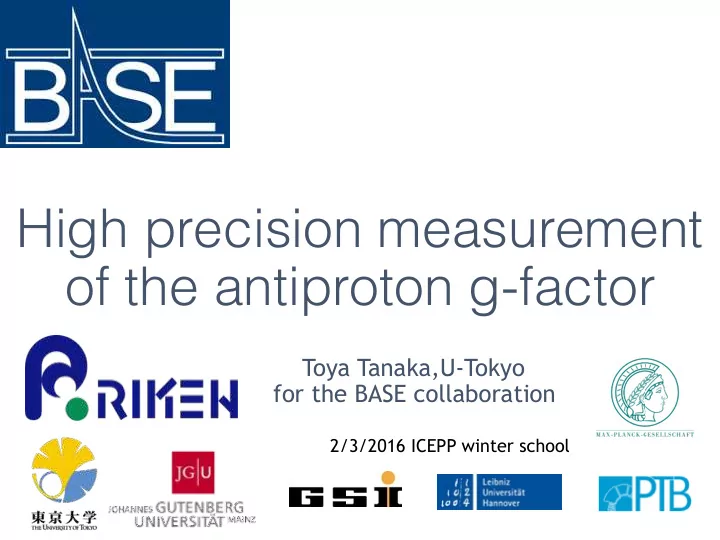

High precision measurement of the antiproton g-factor Toya Tanaka,U-Tokyo for the BASE collaboration 2/3/2016 ICEPP winter school
Outline • Motivation • penning trap and Measurements • BASE apparatus and current situation • Ground loop detection • Summery
Why should we test CPT invariance? matter/antimatter CPT invariance assymmetry Experiment : Measure the fundamental properties of matter/antimatter in high precision. Aim of BASE - precise measurement of proton-antiproton g-factor by penning trap method µ = g q ~ ~ S g: magnetic Moment in units of nuclear magneton 2 m
CPT tests kaon m Δ Recent Past positron g Planned muon g S.Ulmer et al.., Nature. 2015;524:196-199 (2015) antiproton q/m antiproton g antihydrogen 1S/2S antihydrogen GS HFS -21 -18 -15 -12 -9 -6 -3 0 10 10 10 10 10 10 10 10 relative precision
Measurements Cyclotron Motion Larmor Precession g: magnetic Moment in units of B nuclear magneton ν L = g q q ν c = 1 ω L mB mB 4 π 2 π g 2 = ν L ν c g: dimensionless S. Ulmer, A. Mooser et al. PRL 106, S. Ulmer, A. Mooser et al. PRL 107, 253001 (2011) 103002 (2011) g-factor measurement reduces to measurement of a frequency ratio In principle a very simple experiment –> full control, no theoretical corrections
Cyclotron frequency and penning trap B B z 0 ˆ = radial confinement : B 2 " # ρ axial confinement : 2 ( , ) z V c z Φ ρ = − & ' 0 2 2 ( ) V k V 0 V k ( ) z Φ 2 2 2 Invariance-Relation : ν = ν + ν + ν c z + − L. S. Brown and G. Gabrielse, Phys. Rev. A 25 , 2423 (1982).
3 eigenfrequencies of cyclotron frequency r 2 qC 2 • axial frequency m V 0 ν z = • modified cyclotron and magnetron frequency ν ± = 1 p 2( ν c ± ν c 2 − 2 ν z 2 ) Axial( 軸方向 ) 680kHz ν = z 8kHz Magnetron( マグネトロン ) ν = − 28,9MHz ν = Modified Cyclotron( トラップサイクロトロン ) +
Frequency Measurements Measurement of tiny image currents induced in trap electrodes -95 Axially excited, trapped antiprotons -100 Signal (dBm) -105 -110 -115 -120 -125 -130 In thermal equilibrium: 645300 645400 645500 645600 645700 Frequency (Hz) Particles short noise in parallel -90 – Appear as a dip in detector spectrum -95 – -100 Signal (dBm) Width of the dip � number of – -105 particles -110 -115 2 1 R q ' $ N -120 Δ ν = ⋅ % " 2 m D π & # -125 793100 793200 793300 793400 793500 793600 Frequency (Hz) Measurements in thermal equilibrium � tiny volumina / homogeneous condititions Enables cyclotron frequency measurement at ̴̴ 1 ppb
Larmor Frequency Measurement based on continuous Stern Gerlach effect Energy of magnetic dipole in magnetic field Leading order magnetic field correction Spin dependent quadratic axial potential � Axial frequency becomes function of spin state Very difficult for the proton/antiproton system Most extreme magnetic conditions ever applied to single particle. ∆ ν z ∼ 170 m Hz ( ν z ∼ 660kHz )
Larmor Frequency Measurement Spin is detected and analyzed via an axial frequency measurement Larmor Frequency is measured by repetition and evaluating the spin flip probability Together with cyclotron frequency measurement: Statistical Method g/2 = 2.792 848 (24) Rodegheri et al., NJP 14, 063011, (2012) g/2 = 2.792 846 (7) di Sciacca et al., PRL 108, 153001 (2012) Statistical Method: Limited to the ppm level due to the strong magnetic bottle. S. Ulmer et al., Phys. Rev. Lett 106, 253001 (2011)
BASE apparatus
Picture of BASE apparatus
BASE double penning trap
BASE double penning trap RT PT AT 50 antiprotons in reservoir Single antiproton in precision Single antiproton in analysis trap trap trap Signals observed in all trap and g-factor measurement is still ongoing.
Ground loop detection • By ground loop, extra low signal will be on the background and the voltage fluctuation directly affects to the axial frequency! r 2 qC 2 ∆ V m V 0 ν z = < 10 − 6 V 0 ∆ ν z ∼ 170 m Hz ( ν z ∼ 660kHz ) • To avoid it, we should plug out suspect cables or detect the ground loop. P. M. Bellan, Simple system for locating ground loops , Rev. Sci. Instrum. 78 , Art. No. 065104 (2007)
Making prototype • Under Construction…
Summery • For measuring g-factor, only Cyclotron and Lamour frequency should be measured. Principally simple but practically difficult. • By Double penning trap method, the antiproton g-factor measurement is now ongoing even off beam time. • For further measurement, there are many things to be improved, e.g ground loop detector.
Thanks for your attention! The BASE Team S. Ulmer S. Sellner C. Smorra M. Borchert RIKEN RIKEN CERN / RIKEN U - Hannover H. Nagahma T. Higuchi T. Tanaka M. Besirli RIKEN / Tokyo RIKEN / Tokyo RIKEN / Tokyo RIKEN . Matsuda, K. Blaum, Y C. Ospelkaus, W. Quint, J. Walz, Y . Yamazaki A. Mooser G. Schneider J. A. Harrington RIKEN U - Mainz RIKEN
Appendix:results of the proton & antiproton g-factor
Appendix: Concept of CPT violation • different C’s System based on SM CPT violating term Kostelecky et al. Absolute energy resolution (normalized to m-scale) is the relevant measure to characterize sensitivity of an experiment to CPT violation. Single particle measurements in Penning traps give high energy resolution. Relative precision Energy resolution
Appendix: How to measure ν ± ν + = ν rf + ν l + ν r − ν z ν − = ν z 2 2 ν + ν l ν r ( ν + << ν z << ν − )
Recommend
More recommend